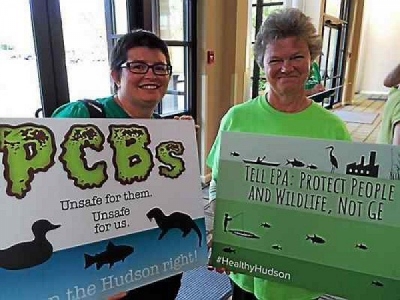
Posted on July 24, 2017
By Paul Post, The Record Business
The 55 years it might take before Hudson River fish are safe for human consumption isn’t good enough for state, local and federal officials, who say General Electric Company’s PCB cleanup project isn’t done.
The U.S. Environmental Protection Agency, which oversaw the court-ordered work, says dredging that ended in 2015, plus natural remediation, will eventually make the river safe.
But critics say the project didn’t encompass a large enough area and that unacceptable levels of PCBs were left behind that still need to be removed.
“A remedy that takes 55 years to be protective is not protective,” said Kevin Farrar, state Department of Enivronmental Conservation geologist. “Our position is that EPA should have made them (GE) do more. You have to change your remedy to meet the goals, not change the goals.”
Farrar said a much more rapid recovery of the river was anticipated under the original agreement.
More than 100 people turned out Wednesday, at Saratoga Hilton Hotel, for an EPA-hosted public meeting to discuss a five-year review of the $2 billion dredging project, which covered a 40-mile stretch of river from Fort Edward to Troy. GE dumped PCBs, a suspected carcinogen, into the river from plants in Hudson Falls and Fort Edward from the 1940s to 1977.
About 310,000 pounds of PCBs and 2.75 million cubic yards of sediment were removed from 2009 to 2015. Crews spent last year restoring vegetative habitat.
At present, an assessment of the floodplain surrounding the river is under way to determine what type of cleanup, if any, might be needed there, too.
“We’re not claiming success,” said Gary Klawinski, EPA Hudson River project manager. “We need more data to determine how well the river is progressing. The cleanup is not yet finished. It’s not fully known yet how we’ve benefited because we don’t have that much data. We need eight years of data to identify fish recovery.”
He said it will take at least 15 years before it’s safe for some people to eat at least one meal every two months, and it could be 55 years before consumption reaches generally accepted levels.
“More dredging would not significantly improve this timeline,” Klawinski said.
But Farrar said the work done to date is not protecting human health and the river’s ecology, as expected. But EPA must admit this and make GE do more cleanup before dredging or other remediation activity resumes, he said.
Local officials say there is no time to wait.
Schuylerville Mayor Dan Carpenter showed large pictures that showed water flooding Fort Hardy Park from the Old Champlain Canal during a recent heavy rainstorm. It’s believed the canal has large amounts of PCBs and other contaminants. The park hosts many youth recreational activities.
The canal is part of the floodplain, outside of the scope of the dredging project. But Carpenter said the EPA should accelerate efforts to get this area cleaned up, too.
“We need to make sure kids are not being exposed,” he said.
Supervisor Thomas Wood, R-Saratoga, said, “We want the river back. We want it safe. Let’s get the job done. Let’s get it done right.”
Assemblywoman Carrier Woerner, D-Round Lake, said, “There are still (PCB) hot spots in Fort Edward and downriver near Waterford and Halfmoon. It affects property values and tourism. It’s not just a health concern. It’s an economic development concern.”
A spokesman for U.S. Rep. Paul Tonko, D-Amsterdam, said, “The current remedy is not protective of human health or the environment. Communities cannot wait decades longer for a safe and healthy river.”
Several individuals and representatives of groups such as Scenic Hudson also spoke during the meeting.
GE spokesman Mark Behan said, “EPA has determined that the dredging project produced the expected declines in PCB levels in water and fish, and will be protective of human health and the environment. The agency concluded again there is no need for additional dredging in the upper or lower Hudson.
“GE agrees with EPA’s findings, and is pleased with the results of the dredging project,” he said. “We will continue to support the ongoing assessment of environmental conditions in the river and will work closely with EPA, New York State, local communities and others committed to the goal of a cleaner Hudson.”
A public comment period on the EPA’s five-year review of the cleanup project ends Sept. 1. People may submit comments by email to: epahrfo@outlook.com.
Source: The Saratogian





